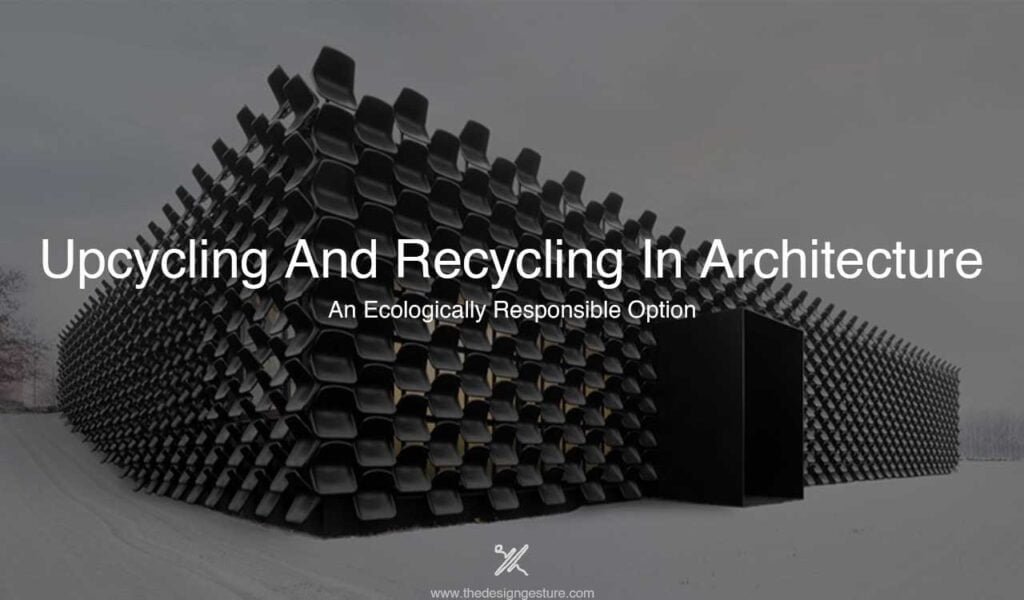Table of Contents
What is upcycling and recycling?
The process of transforming waste resources into new resources and things is known as recycling. It frequently included the notion of recovering energy from waste in this concept. The basic procedures in recycling are the collection of waste materials, their processing or manufacturing into new products, and the purchase of those commodities that can subsequently be recycled.

Upcycling is indeed the act of converting waste materials, unwanted or undesirable things to innovative products and materials of higher quality and with artistic or economic value. As a result, the final product is more useful, valuable, and attractive than it was before.

Difference between upcycling and recycling
Upcycling takes waste and develops something new from it in its existing state, whereas recycling eliminates waste in order to produce anything useful. Upcycling keeps the object’s original form and allows it to be identified. Upcycling is more creative than recycling and can use a wide range of techniques and materials to produce the finished result. Upcycling reduces the need for recycling, making it a more ecologically responsible option.
Upcycling in architecture
‘Upcycling’ refers to the process of repurposing a product, material, or waste by improving its quality and value beyond its initial form. The building industry, which primarily uses materials like brick, concrete, steel, glass, wood, etc, accounts for roughly 40% of the trash produced on this planet. The building industry created over 1.3 billion tonnes of garbage in 2012. By 2025, this number is expected to increase to 2.2 billion tonnes. The major building materials like brick, concrete, steel, glass, timber, etc., account for the great majority of this waste, and the excessive demand for these resources necessitates their efficient reuse.
This is why upcycling has become so popular in architecture, and given current trends, it is not going to fade away anytime soon. Upcycling is a broad notion that evolves with new ideas. Raw materials or various materials are sometimes used or altered as new materials; other times, techniques and talents have aided in the process’s simplification. The most common ways are product-based, in which theoretically recyclable materials are used directly after few or no modifications, and recycling resources are mixed to create a new product with little energy usage.
COLLAGE HOUSE, NAVI MUMBAI, INDIA
One of the best-shown examples of upcycling in architectural aspects is Collage House in Navi Mumbai, India. The name of this place is “Kanha”. S+PS architects are the firm in charge of the project. The project type is residential, it covers an area of 520 square meters and was constructed in 2015. The basic concept of the project is to reuse salvaged building materials to create attractive collages of old and new elements.
This house has 5 bedrooms and 5 bathrooms with a complete facility for rainwater harvesting, a courtyard on 1 floor, and other services, and parking for 3 on the ground floor. On the terrace, there is a pavilion. The pooja room is grounded in the shape of a drum that has been cut in half.
The users believe in reusing waste as there is a huge amount of waste around us. The front facade is covered with a collage of discarded windows and doors contrasted with a blue glass balcony. Leftover pieces of pipes were used to create a pipe wall with help in creating a functional rainwater harvesting system whose capacity was around 50000 liters. For the interior, they had created a chair using the fabric waste(chindi). There is an element in a room in which they have created a partition out of waste printing blocks.
Recycling in architecture
Recycling has been around for a long time, primarily on a very small scale where individuals decrease waste and conserve energy. In the architectural field, reusing and recycling materials are gradually gaining popularity as viable alternatives to traditional building materials. Using recycled materials not only saves money on raw materials, but it also leads to the creation of recycling facilities, which creates jobs in the area. Most building materials are now recyclable, allowing for a new aesthetic perspective and expression to be applied to a project. Materials such as used tyres and soda cans, in addition to wood and plastic, are being employed.
The use of recycled materials has increased since we realised the negative impact of buildings on the environment. In which 40% of total carbon emissions come from buildings. Recycled materials reduce this percentage since they use fewer raw materials and hence require less energy to manufacture. They also reduce the amount of building waste. Architects and designers, on the other hand, would never pass up an opportunity to be unique and original.
Ecoark Taipei Taiwan
Plastic bottle architecture succeeds at repurposing a problem into a green opportunity. One such example is the incredible EcoARK in Taipei, Taiwan. This gigantic pavilion, made of 1.5 million recycled plastic bottles, is unexpectedly strong enough to endure natural forces such as fires and earthquakes! This 9 story $3 million USD pavilion, designed by Arthur Huang, is powered by solar panels and erected according to the “Reduce, Reuse, and Recycle” credo.
Benefits
Environmental benefits include preventing waste from going to the landfill. Minimize the use of resources, leading to reduced need for raw materials, thereby cutting down on pollution levels and energy consumption.
Economic and social benefits include celebrating artisanal labour and old-school craftsmanship, helping small and rural industries, increasing economic stability by harnessing a local source of materials, and lower manufacturing prices.
Conclusion
Architecture is all about innovation and technology, which combines to form an aesthetic built form. In addition to reducing your carbon footprint, upcycling and recycling also save energy, reduces greenhouse gas emissions, prevent pollution, etc. We can better preserve our natural resources by recycling and upcycling more. These techniques can also serve as interior products and design. Upcycling and recycling play a vital role in maintaining the sustainability and create a creative mindset among different individuals. It also promotes the 3R’s that is Reduce, Recycle, Reuse.







